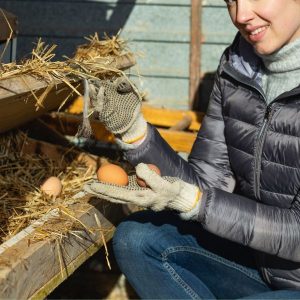Bring more eggs in from the cold!
 As cold winter weather approaches and the days grow shorter, your normally productive hens may be challenged to stay productive, and the cold weather may take its toll on the eggs they do lay. How can you keep your hens in optimal laying condition and assure that their eggs are the highest quality possible while helping the birds live their best lives in the dark, cold months of winter?
As cold winter weather approaches and the days grow shorter, your normally productive hens may be challenged to stay productive, and the cold weather may take its toll on the eggs they do lay. How can you keep your hens in optimal laying condition and assure that their eggs are the highest quality possible while helping the birds live their best lives in the dark, cold months of winter?
Let’s look at some important factors to consider with regard to winter egg production.
Egg Care
Check your nest boxes early in the morning and several times a day, depending on how cold it is. Collecting eggs often prevent them from freezing and expanding, which leads to cracked shells. You can also winterize your nest boxes to help prevent your eggs from freezing:
- Ideally, your nest boxes will be in the interior of the coop.
- Insulate your nest boxes by cutting pieces of cardboard to fit the sides, top, and bottom. Do not use insulation! Chickens will eat it.
- Put deep bedding, such as pine shavings or chopped straw, in the nest boxes.
- Make curtains for the nest box entrances from a heavy cloth, such as wool.
If you find a cracked egg, assess how bad the damage is. If only the shell is broken and the membranes are intact, wash the egg and eat it right away. If the membranes are broken, discard the egg. Do not feed broken eggs to the chickens; they will break and eat their own eggs once they realize how tasty they are!
Mental and Physical Health
The winter months can bring boredom, leading to pecking problems, also called flockmate persecution. Provide enrichment for your hens, such as scratch scattered in bedding/litter, a cabbage hung from the ceiling of the run, and suet baskets with lettuce and other vegetable treats (not suet!) tucked inside.
Nutrena’s scratch grains can provide energy and keep your birds’ metabolism going at night when it’s cold! Feed only a handful of scratch in the evening. Be careful not to overfeed; extra fat on their body can lead to egg binding and other health issues.
Winterizing Your Coop
While chickens can tolerate low temperatures, sudden temperature changes can be challenging for them. A heat source such as a lightbulb in a safety cage (Beware: it’s a potential fire hazard!) or heat panels can be used to raise the temperature about 10° F above the outdoor temperature. Heat only part of the coop; this allows the birds to choose where they are most comfortable. Other ways to winterize the coop include
- putting extra bedding in the coop;
- providing heated perches;
- making sure the coop is well ventilated;
- eliminating moisture and drafts, especially around roosts; and
- covering the coop and part of the run with tarps or heavy plastic (not blankets).
You can find more tips and suggestions for winterizing your coop in this post.
Light
Chickens lay in response to the photoperiod, or amount of light they get per day. They need about 14 hours of light per day to lay their best. Check out the post “Feeding Chickens in Winter” for more information.
You can supplement light by installing a bulb that comes on in the early morning. For more information, you can read this post. If you do choose to provide extra light, it’s best to limit it to 16 hours per day. However, you may choose to give their bodies a break for the winter months.
Water
Fresh water is critical for egg production. Your birds’ bodies and their eggs are mostly water, and they need to continually replenish this vital element. Slight dehydration may cause hens to go out of lay. Winter presents unique challenges because waterers freeze quickly. Heated waterers are especially helpful, but they require an electric outlet in the coop or a very long extension cord. Another alternative is to have a couple of waterers so you can place a fresh one outside for your birds while the other is inside thawing.
Feed
Once you’ve addressed the factors above, consider if your birds are getting the nutrition they need to be productive. Continue to feed your birds a balanced layer ration even though they might not be laying. They will need to be in top shape when days start to lengthen to go back into lay. Your birds will eat a bit more in the winter, so keep the food available at all times.
A 2020 study, conducted in 10.5 daylight hours at 12° F, showed the importance of a nutritionally well-balanced feed that includes ingredients like pre- and probiotics, yeast culture, essential oils, and Vitamin D3. In the study, hens fed NatureWise with FlockShield and essential oils not only kept laying, but they also produced thicker, stronger shells with no broken eggs. After three weeks of eating this diet, egg production increased by 325%.
As winter approaches, make sure to include NatureWise Poultry Feed as a balanced source of proper nutrition to keep your hens happy, healthy-and laying!
Find the original article and more articles like this at Nutrena, Scoop from the Coop